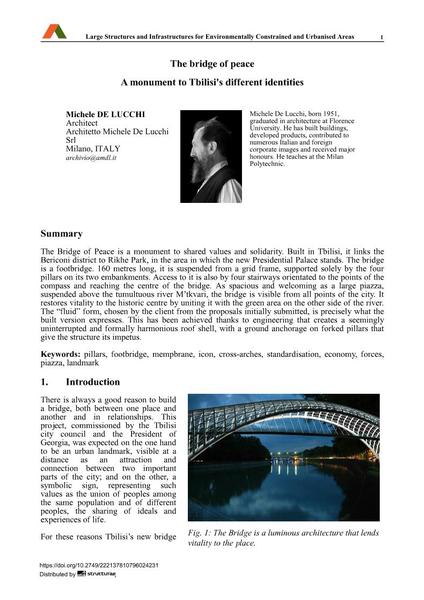The bridge of peace
A Monument to Tbilisi's Different Identities

|
|
|||||||||||
Bibliografische Angaben
| Autor(en): |
Michele De Lucchi
|
||||
|---|---|---|---|---|---|
| Medium: | Tagungsbeitrag | ||||
| Sprache(n): | Englisch | ||||
| Tagung: | IABSE Symposium: Large Structures and Infrastructures for Environmentally Constrained and Urbanised Areas, Venice, Italy, 22-24 September 2010 | ||||
| Veröffentlicht in: | IABSE Symposium Venice 2010 | ||||
|
|||||
| Seite(n): | 200-201 | ||||
| Anzahl der Seiten (im PDF): | 8 | ||||
| Jahr: | 2010 | ||||
| DOI: | 10.2749/222137810796024231 | ||||
| Abstrakt: |
The Bridge of Peace is a monument to shared values and solidarity. Built in Tbilisi, it links the Bericoni district to Rikhe Park, in the area in which the new Presidential Palace stands. The bridge is a footbridge. 160 metres long, it is suspended from a grid frame, supported solely by the four pillars on its two embankments. Access to it is also by four stairways orientated to the points of the compass and reaching the centre of the bridge. As spacious and welcoming as a large piazza, suspended above the tumultuous river M’tkvari, the bridge is visible from all points of the city. It restores vitality to the historic centre by uniting it with the green area on the other side of the river. The “fluid” form, chosen by the client from the proposals initially submitted, is precisely what the built version expresses. This has been achieved thanks to engineering that creates a seemingly uninterrupted and formally harmonious roof shell, with a ground anchorage on forked pillars that give the structure its impetus. |
||||
| Stichwörter: |
Fußgängersteg Fußgängerbrücke
|
||||
